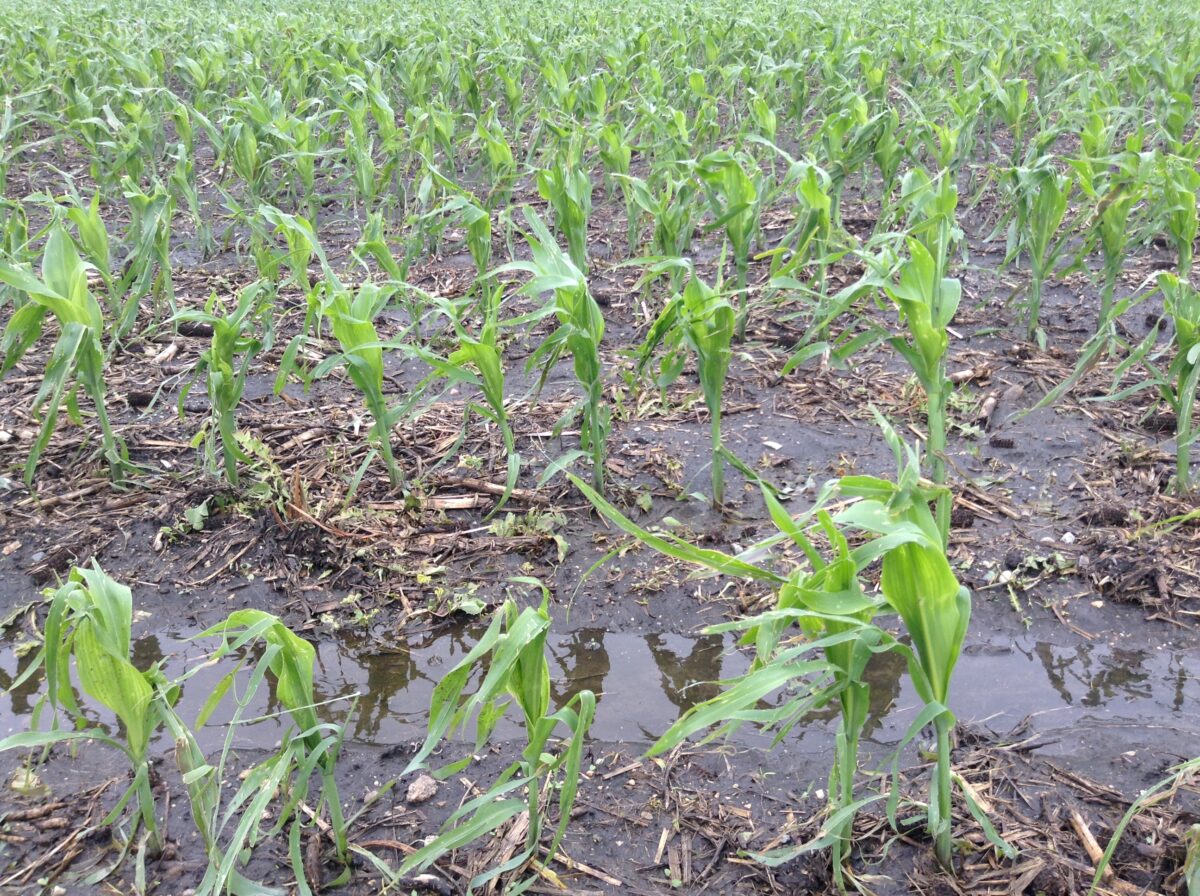The Impact of Mid-Season Excess Moisture

It is well-known that spring weather in Manitoba is unpredictable. Farmers endure drought conditions one season and excess moisture the next, never knowing for sure what is ahead. These dubious conditions make crop planning particularly difficult because no one knows what extremes of moisture crops may or may not have to grow through that season.
Generally, crops should endure excess moisture fairly well in early summer, when they are actively growing vegetatively, and environmental conditions are usually conducive to evaporation. The growth curve is quite steep during this time, especially in the large-sized crops like corn and sunflower and their water uptake is generous if conditions are good. Flax is not going to be a crop that tolerates “wet feet,” and it will be evident if it is in standing water for extended periods.
Corn
Corn that is past V6 staging has the growing point above ground, so flooding at this stage isn’t quite as detrimental as it would be at earlier stages. Remember that where there is standing water, there is no oxygen exchange and living cells cannot survive without it for very long. Ideally, conditions do not get too hot (crop stress) and evaporation and/or water drainage can happen quickly. Depending on how many times the flooded areas have been flooded this season, this influences the ability of the crop to “bounce back.” Root death is possible in this scenario and warm, dry soils will be required to generate new root growth. New root growth is possible in corn in these situations, but the new growth will extend horizontally, which leads to a few implications with nutrient uptake and plant stability.
In younger plants, V5 or smaller, being waterlogged for four days would be a maximum time span to survive and recover. It is harder to determine what that is for larger plants that are growing much more quickly, especially if there have been multiple heavy precipitation events that have left fields saturated and/or puddled. It is also exceedingly difficult to determine what nitrogen losses may be, and even more so when top-dress applications have occurred recently. At this stage and in the days ahead, it would be very important to keep an eye out for nitrogen deficiency symptoms. Corn nitrogen uptake is about 60 per cent of total uptake from the V8 to silking stages, so losing access to nitrogen via leaching or denitrification could seriously impact yield.
Sunflower
Sunflowers are growing rapidly in July and moving quickly into the reproductive stages. At this time, the crop can be using up to 1/3 inch of water each day. It is hard to believe that with this excessive water use that the crop wouldn’t manage saturated soils very well, but the roots do still need to breathe. Photosynthesis also slows down while stomata remain open in wet conditions, which slows plant development. In flooded conditions, sunflowers may have a tolerance for about three-plus days in an anaerobic environment. During those conditions and following, crop recovery is better with cloudy and cool-warm weather rather than hot and sunny weather.
Sunflowers are also very susceptible to stalk diseases during this vegetative growth, including sclerotinia basal rot. Sclerotinia infections can occur anytime between early vegetative stages through to seed fill and generally need precipitation to spread their spores. It is an important consideration for farmers and agronomists and recommended to know the high risk of disease that the crop carries in wet environments.
Flax
Flax has the lowest tolerance to flooding of the three specified crops. It is a small, shallow-rooted crop that does not adapt well to extreme conditions, nor does it have a need for high amounts of water to grow. If it remains in standing water for longer than three days, flax will become stunted, yellow and there will be a high risk of yield loss.
Flax requires the bulk of its water during flowering and seed fill, at roughly 0.28 inches/day. It is also known that dirty (weedy) flax fields use water much less efficiently than clean flax fields. The one benefit to flax in wet fields is that it is not as susceptible to stem diseases as most other Manitoba oilseeds, therefore wet conditions are not a matter of concern with regards to yield or quality loss due to disease.
